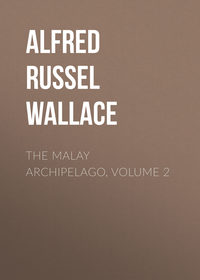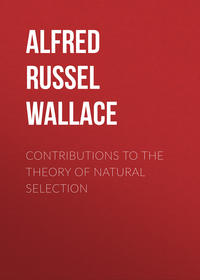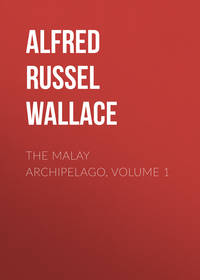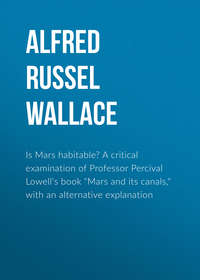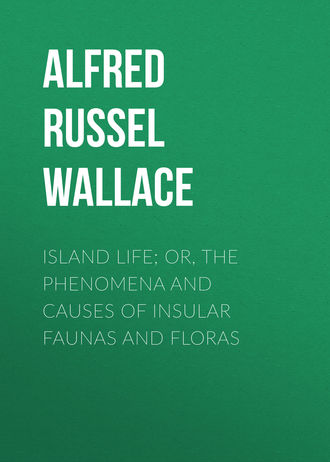 полная версия
полная версияIsland Life; Or, The Phenomena and Causes of Insular Faunas and Floras
Geologists have measured with some accuracy the maximum thickness of all the known sedimentary rocks. The rate of denudation has also been recently measured by a method which, if not precise, at all events gives results of the right order of magnitude and which err on the side of being too slow rather than too fast. If, then, the maximum thickness of the known sedimentary rocks is taken to represent the average thickness of all the sedimentary rocks, and we also know the amount of sediment carried to the sea or lakes, and the area over which that sediment is spread, we have a means of calculating the time required for the building up of all the sedimentary rocks of the geological system. I have here inquired how far the above suppositions are correct, or on which side they probably err; and the conclusion arrived at is, that the time required is very much less than has hitherto been supposed.
Another estimate is afforded by the date of the last glacial epoch if coincident with the last period of high excentricity, while the Alpine glaciation of the Miocene period is assumed to have been caused by the next earlier phase of very high excentricity. Taking these as data, the proportionate change of the species of mollusca affords a means of arriving at the whole lapse of time represented by the fossiliferous rocks; and these two estimates agree in the order of their magnitudes.
It is then argued that the changes of climate every 10,500 years during the numerous periods of high excentricity have acted as a motive power in hastening on both geological and biological change. By raising and lowering the snow-line in all mountain ranges it has caused increased denudation; while the same changes have caused much migration and disturbance in the organic world, and have thus tended to the more rapid modification of species. The present epoch being a period of very low excentricity, the earth is in a phase of exceptional stability both physical and organic; and it is from this period of exceptional stability that our notions of the very slow rate of change have been derived.
The conclusion is, on the whole, that the periods allowed by physicists are not only far in excess of such as are required for geological and organic change, but that they allow ample margin for a lapse of time anterior to the deposit of the earliest fossiliferous rocks several times longer than the time which has elapsed since their deposit to the present day.
Having thus laid the foundation for a scientific interpretation of the phenomena of distribution, we proceed to the Second Part of our work—the discussion of a series of typical Insular Faunas and Floras with a view to explain the interesting phenomena they present. Taking first two North Atlantic groups—the Azores and Bermuda—it is shown how important an agent in the dispersal of most animals and plants is a stormy atmosphere. Although 900 and 700 miles respectively from the nearest continents, their productions are very largely identical with those of Europe and America; and, what is more important, fresh arrivals of birds, insects, and plants, are now taking place almost annually. These islands afford, therefore, test examples of the great dispersive powers of certain groups of organisms, and thus serve as a basis on which to found our explanations of many anomalies of distribution. Passing on to the Galapagos we have a group less distant from a continent and of larger area, yet, owing to special conditions, of which the comparatively stormless equatorial atmosphere is the most important, exhibiting far more speciality in its productions than the more distant Azores. Still, however, its fauna and flora are as unmistakably derived from the American continent as those of the Azores are from the European.
We next take St. Helena and the Sandwich Islands, both wonderfully isolated in the midst of vast oceans, and no longer exhibiting in their productions an exclusive affinity to one continent. Here we have to recognise the results of immense antiquity, and of those changes of geography, of climate, and in the general distribution of organisms which we know have occurred in former geological epochs, and whose causes and consequences we have discussed in the first part of our volume. This concludes our review of the Oceanic Islands.
Coming now to Continental Islands we consider first those of most recent origin and offering the simplest phenomena; and begin with the British Isles as affording the best example of very recent and well known Continental Islands. Reviewing the interesting past history of Britain, we show why it is comparatively poor in species and why this poverty is still greater in Ireland. By a careful examination of its fauna and flora it is then shown that the British Isles are not so completely identical, biologically, with the continent as has been supposed. A considerable amount of speciality is shown to exist, and that this speciality is real and not apparent is supported by the fact, that small outlying islands, such as the Isle of Man, the Shetland Isles, Lundy Island, and the Isle of Wight, all possess certain species or varieties not found elsewhere.
Borneo and Java are next taken, as illustrations of tropical islands which may be not more ancient than Britain, but which, owing to their much larger area, greater distance from the continent, and the extreme richness of the equatorial fauna and flora, possess a large proportion of peculiar species, though these are in general very closely allied to those of the adjacent parts of Asia. The preliminary studies we have made enable us to afford a simpler and more definite interpretation of the peculiar relations of Java to the continent and its differences from Borneo and Sumatra, than was given in my former work (The Geographical Distribution of Animals).
Japan and Formosa are next taken, as examples of islands which are decidedly somewhat more ancient than those previously considered, and which present a number of very interesting phenomena, especially in their relations to each other, and to remote rather than to adjacent parts of the Asiatic continent.
We now pass to the group of Ancient Continental Islands, of which Madagascar is the most typical example. It is surrounded by a number of smaller islands which may be termed its satellites since they partake of many of its peculiarities; though some of these—as the Comoros and Seychelles—may be considered continental, while others—as Bourbon, Mauritius, and Rodriguez—are decidedly oceanic. In order to understand the peculiarities of the Madagascar fauna we have to consider the past history of the African and Asiatic continents, which it is shown are such as to account for all the main peculiarities of the fauna of these islands without having recourse to the hypothesis of a now-submerged Lemurian continent. Considerable evidence is further adduced to show that "Lemuria" is a myth, since not only is its existence unnecessary, but it can be proved that it would not explain the actual facts of distribution. The origin of the interesting Mascarene wingless birds is discussed, and the main peculiarities of the remarkable flora of Madagascar and the Mascarene islands pointed out; while it is shown that all these phenomena are to be explained on the general principles of the permanence of the great oceans and the comparatively slight fluctuations of the land area, and by taking account of established palæontological facts.
There remain two other islands—Celebes and New Zealand—which are classed as "anomalous," the one because it is almost impossible to place it in any of the six zoological regions, or determine whether it has ever been actually joined to a continent—the other because it combines the characteristics of continental and oceanic islands.
The peculiarities of the Celebesian fauna have already been dwelt upon in several previous works, but they are so remarkable and so unique that they cannot be omitted in a treatise on "Insular Faunas"; and here, as in the case of Borneo and Java, fuller consideration and the application of the general principles laid down in our First Part, lead to a solution of the problem at once more simple and more satisfactory than any which have been previously proposed. I now look upon Celebes as an outlying portion of the great Asiatic continent of Miocene times, which either by submergence or some other cause had lost the greater portion of its animal inhabitants, and since then has remained more or less completely isolated from every other land. It has thus preserved a fragment of a very ancient fauna along with a number of later types which have reached it from surrounding islands by the ordinary means of dispersal. This sufficiently explains all the peculiar affinities of its animals, though the peculiar and distinctive characters of some of them remain as mysterious as ever.
New Zealand is shown to be so completely continental in its geological structure, and its numerous wingless birds so clearly imply a former connection with some other land (as do its numerous lizards and its remarkable reptile, the Hatteria), that the total absence of indigenous land-mammalia was hardly to be expected. Some attention is therefore given to the curious animal which has been seen but never captured, and this is shown to be probably identical with an animal referred to by Captain Cook. The more accurate knowledge which has recently been obtained of the sea bottom around New Zealand enables us to determine that the former connection of that island with Australia was towards the north, and this is found to agree well with many of the peculiarities of its fauna.
The flora of New Zealand and that of Australia are now both so well known, and they present so many peculiarities, and relations of so anomalous a character, as to present in Sir Joseph Hooker's opinion an almost insoluble problem. Much additional information on the physical and geological history of these two countries has, however, been obtained since the appearance of Sir Joseph Hooker's works, and I therefore determined to apply to them the same method of discussion and treatment which has been usually successful with similar problems in the case of animals. The fact above noted, that New Zealand was connected with Australia in its northern and tropical portion only, of itself affords a clue to one portion of the specialities of the New Zealand flora—the presence of an unusual number of tropical families and genera, while the temperate forms consist mainly of species either identical with those found in Australia or closely allied to them. But a still more important clue is obtained in the geological structure of Australia itself, which is shown to have been for long periods divided into an eastern and a western island, in the latter of which the highly peculiar flora of temperate Australia was developed. This is found to explain with great exactness the remarkable absence from New Zealand of all the most abundant and characteristic Australian genera, both of plants and of animals, since these existed at that time only in the western island, while New Zealand was in connection with the eastern island alone and with the tropical portion of it. From these geological and physical facts, and the known powers of dispersal of plants, all the main features, and many of the detailed peculiarities of the New Zealand flora are shown necessarily to result.
Our last chapter is devoted to a wider, and if possible more interesting subject—the origin of the European element in the floras of New Zealand and Australia, and also in those of South America and South Africa. This is so especially a botanical question, that it was with some diffidence I entered upon it, yet it arose so naturally from the study of the New Zealand and Australian floras, and seemed to have so much light thrown upon it by our preliminary studies as to changes of climate and the causes which have favoured the distribution of plants, that I felt my work would be incomplete without a consideration of it. The subject will be so fresh in the reader's mind that a complete summary of it is unnecessary. I venture to think, however, that I have shown, not only the several routes by which the northern plants have reached the various southern lands, but have pointed out the special aids to their migration, and the motive power which has urged them on.
In this discussion, if nowhere else, will be found a complete justification of that lengthy investigation of the exact nature of past changes of climate, which to some readers may have seemed unnecessary and unsuited to such a work as the present. Without the clear and definite conclusions arrived at by that discussion, and those equally important views as to the permanence of the great features of the earth's surface, and the wonderful dispersive powers of plants which have been so frequently brought before us in our studies of insular floras, I should not have ventured to attack the wide and difficult problem of the northern element in southern floras.
In concluding a work dealing with subjects which have occupied my attention for many years, I trust that the reader who has followed me throughout will be imbued with the conviction that ever presses upon myself, of the complete interdependence of organic and inorganic nature. Not only does the marvellous structure of each organised being involve the whole past history of the earth, but such apparently unimportant facts as the presence of certain types of plants or animals in one island rather than in another, are now shown to be dependent on the long series of past geological changes—on those marvellous astronomical revolutions which cause a periodic variation of terrestrial climates—on the apparently fortuitous action of storms and currents in the conveyance of germs—and on the endlessly varied actions and reactions of organised beings on each other. And although these various causes are far too complex in their combined action to enable us to follow them out in the case of any one species, yet their broad results are clearly recognisable; and we are thus encouraged to study more completely every detail and every anomaly in the distribution of living things, in the firm conviction that by so doing we shall obtain a fuller and clearer insight into the course of nature, and with increased confidence that the "mighty maze" of Being we see everywhere around us is "not without a plan."
1
A small number of species belonging to the West Indies are found in the extreme southern portion of the Florida Peninsula.
2
I cannot avoid here referring to the enormous waste of labour and money with comparatively scanty and unimportant results to natural history of most of the great scientific voyages of the various civilized governments during the present century. All these expeditions combined have done far less than private collectors in making known the products of remote lands and islands. They have brought home fragmentary collections, made in widely scattered localities, and these have been usually described in huge folios or quartos, whose value is often in inverse proportion to their bulk and cost. The same species have been collected again and again, often described several times over under new names, and not unfrequently stated to be from places they never inhabited. The result of this wretched system is that the productions of some of the most frequently visited and most interesting islands on the globe are still very imperfectly known, while their native plants and animals are being yearly exterminated, and this is the case even with countries under the rule or protection of European governments. Such are the Sandwich Islands, Tahiti, the Marquesas, the Philippine Islands, and a host of smaller ones; while Bourbon and Mauritius, St. Helena, and several others, have only been adequately explored after an important portion of their productions has been destroyed by cultivation or the reckless introduction of goats and pigs. The employment in each of our possessions, and those of other European powers, of a resident naturalist at a very small annual expense, would have done more for the advancement of knowledge in this direction than all the expensive expeditions that have again and again circumnavigated the globe.
3
The general facts of Palæontology, as bearing on the migrations of animal groups, are summarised in my Geographical Distribution of Animals, Vol. I. Chapters VI., VII., and VIII.
4
Since these lines were written, a fine series of specimens of this rare humming-bird has been obtained from the same locality. (See Proc. Zool. Soc. 1881, pp. 827-834.)
5
Many of these large genera are now subdivided, the divisions being sometimes termed genera, sometimes sub-genera.
6
The Palæarctic region includes temperate Asia and Europe, as will be explained in the next chapter.
7
The following list of the genera of reptiles and amphibia peculiar to the Palæarctic Region has been furnished me by Mr. G. A. Boulenger, of the British Museum:—

8
Remains of the dingo have been found fossil in Pleistocene deposits but the antiquity of man in Australia is not known. It is not, however, improbable that it may be as great as in Europe. My friend A. C. Swinton, Esq., while working in the then almost unknown gold-field of Maryborough, Victoria, in January, 1855, found a fragment of a well-formed stone axe resting on the metamorphic schistose bed-rock about five feet beneath the surface. It was overlain by the compact gravel drift called by the miners "cement," and by an included layer of hard iron-stained sandstone. The fragment is about an inch and three-eighths wide and the same length, and is of very hard fine-grained black basalt. One side is ground to a very smooth and regular surface, terminating in a well-formed cutting edge more than an inch long, the return face of the cutting part being about a quarter of an inch wide. The other side is a broken surface. The weapon appears to have been an axe or tomahawk closely resembling that figured at p. 335 of Lumholtz's Among Cannibals, from Central Queensland. The fragment was discovered by Mr. Swinton and the late Mr. Mackworth Shore, one of the discoverers of the gold-field, before any rush to it had taken place, and it seems impossible to avoid the conclusion that it was formed prior to the deposit of the gravel drift and iron-stained sandstone under which it lay. This would indicate a great antiquity of man in Australia, and would enable us to account for the fossilised remains of the dingo in Pleistocene deposits as those of an animal introduced by man.
9
These facts are taken from a memoir on The Mammals and Winter Birds of Florida, by J. A. Allen; forming Vol. II., No. 3, of the Bulletin of the Museum of Comparative Zoology at Harvard College, Cambridge, Massachusetts.
10
The great variation in wild animals is more fully discussed and illustrated in the author's Darwinism (Chapter III.).
11
See Ibis, 1879, p. 32.
12
In Mr. Seebohm's latest work, Birds of the Japanese Empire (1890), he says, "Examples from North China are indistinguishable from those obtained in Greece" (p. 82).
13
Ibis, 1879, p. 40. In his Birds of the Japanese Empire (1890), Mr. Seebohm classes the Japanese and European forms as E. schœniclus, and thinks that their range is probably continuous across the two continents.
14
Lyell's Principles of Geology, ii., p. 369.
15
Mr. Darwin found that the large Helix pomatia lived after immersion in sea-water for twenty days. It is hardly likely that this is the extreme limit of their powers of endurance, but even this would allow of their being floated many hundred miles at a stretch, and if we suppose the shell to be partially protected in the crevice of a log of wood, and to be thus out of water in calm weather, the distance might extend to a thousand miles or more. The eggs of fresh-water mollusca, as well as the young animals, are known to attach themselves to the feet of aquatic birds, and this is probably the most efficient cause of their very wide diffusion.
16
Principles of Geology, 11th Ed., Vol. I., p. 258.
17
On Limestone as an Index of Geological Time.
18
In his Preliminary Report on Oceanic Deposit, Mr. Murray says:—"It has been found that the deposits taking place near continents and islands have received their chief characteristics from the presence of the debris of adjacent lands. In some cases these deposits extend to a distance of over 150 miles from the coast." (Proceedings of the Royal Society, Vol. XXIV. p. 519.)
"The materials in suspension appear to be almost entirely deposited within 200 miles of the land." (Proceedings of the Royal Society of Edinburgh, 1876-77, p. 253.)
19
Geographical Evolution. (Proceedings of the Royal Geographical Society. 1879, p. 426.)
20
Professor Dana was, I believe, the first to point out that the regions which, after long undergoing subsidence and accumulating vast piles of sedimentary deposit have been elevated into mountain ranges, thereby become stiff and unyielding, and that the next depression and subsequent upheaval will be situated on one or the other sides of it; and he has shown that, in North America, this is the case with all the mountains of the successive geological formations. Thus, depressions, and elevations of extreme slowness but often of vast amount, have occurred successively in restricted adjacent areas; and the effect has been to bring each portion in succession beneath the ocean but always bordered on one or both sides by the remainder of the continent, from the denudation of which the deposits are formed which, on the subsequent upheaval, become mountain ranges. (Manual of Geology, 2nd Ed., p. 751.)
21
Nature, Vol. II., p. 297.
22
Sir W. Thomson, Voyage of Challenger, Vol. II., p. 374.
23
The following is the analysis of the chalk at Oahu:—
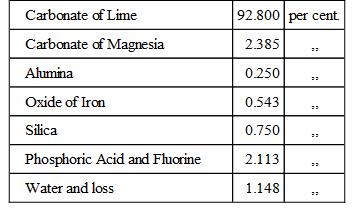
This chalk consists simply of comminuted corals and shells of the reef. It has been examined microscopically and found to be destitute of the minute organisms abounding in the chalk of England. (Geology of the United States Exploring Expedition, p. 150.) Mr. Guppy also found chalk-like coral limestones containing 95 p.c. of carbonate of lime in the Solomon Islands.
The absence of Globigerinæ is a local phenomenon. They are quite absent in the Arafura Sea, and no Globigerina-ooze was found in any of the enclosed seas of the Pacific, but with these exceptions the Globigerinæ "are really found all over the bottom of the ocean." (Murray on Oceanic Deposits—Proceedings of Royal Society, Vol. XXIV., p. 523.)
The above analysis shows a far closer resemblance to chalk than that of the Globigerina-ooze of the Atlantic, four specimens of which given by Sir W. Thomson (Voyage of the Challenger Vol. II. Appendix, pp. 374-376, Nos. 9, 10, 11 and 12) from the mid-Atlantic, show the following proportions:—
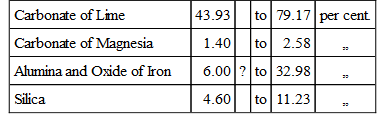
In addition to the above there is a quantity of insoluble residue consisting of small particles of sanidine, augite, hornblende, and magnetite, supposed to be the product of volcanic dust or ashes carried either in the air or by ocean currents. This volcanic matter amounts to from 4.60 to 8.33 per cent. of the Globigerina-ooze of the mid-Atlantic, where it seems to be always present; and the small proportion of similar matter in true chalk is another proof that its origin is different, and that it was deposited far more rapidly than the oceanic ooze.




